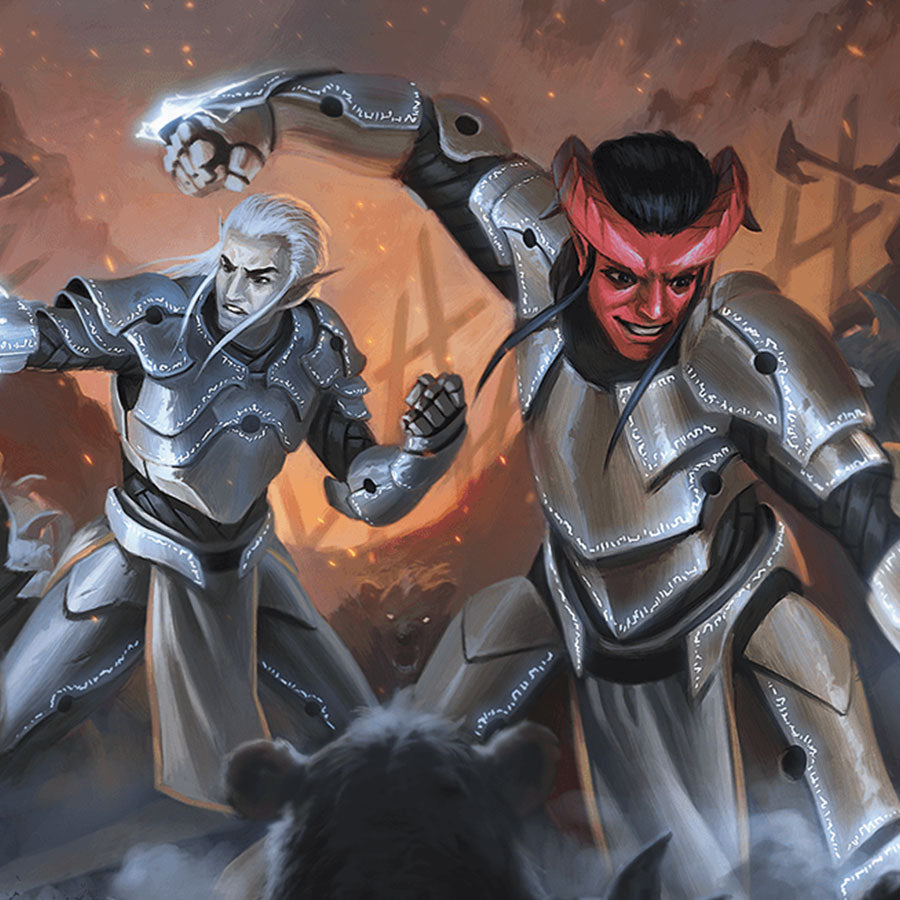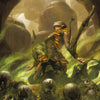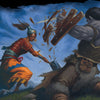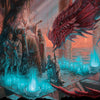15 Techniques to Keep D&D Players Engaged

Written by Luke Hart
THIS is every dungeon master’s worst nightmare. You prepare a game, working your butt off, and then your players don't pay attention during the game session and are ultra distracted by nearly everything. THIS is the sort of disaster that we all dread because every dungeon master out there wants to run an awesome game that their players love and where everyone has fun. But if your players aren’t paying attention and they’re on their phones the entire game, can we really say that’s true? No, probably not.
Hi, I’m Luke Hart, and on this site, I share my nearly 30 years of game master experience so that you can run amazing games that your players will love. And today we’re talking about how to run a Dungeons & Dragons game that will captivate your players, keep them engaged and off their phones, and maybe, maybe—just maybe…--even make them love your game.
Watch or listen to this article by clicking the video below.
#1 Use the Three Pillars
I have found that many D&D games tend to focus exclusively on just one of the three pillars: either combat or social interactions—that's the talkie talkie stuff where you're engaging with NPC's and talking in character. The problem is that when your game only does one thing, that can get monotonous and boring for players. Even combat junkies can get bored if that's all there is. And from time to time even thespians want to plunge their daggers into someone's back. So, you want to include game elements from the three pillars as we call them: combat, social interaction, and exploration. Doing so will make your games so much better, and keep your players more engaged. Now, I have an entire video about using the three pillars that I will throw a link to down below if you want to watch it after this video is over.
#2 Describe and Narrate
I don't know exactly what kind of game you're accustomed to playing, and I hope that I'm not about to describe your game because then I might offend some people. And heaven forbid that I want to do that! But I've been in games before where neither the game master nor the players described anything. The game consisted solely of game mechanics. So in combat you would say that you are moving your paladin here and doing X thing. And then the enemies would move over here and then do their super horrible crazy attack that would make the paladin cry for his Mama. But there was no description. There was no narration. It was just declaring a game mechanic, rolling dice, and doing math. I don't know about you, but for me games like that are horrible.
I want to be able to envision the amazing action that's taking place. And the only way I can do that is if someone is describing it. Sure many times that maybe the game master, but players should be doing that as well. And when the action and the game is being described and narrated, the entire game comes alive to players and dungeon master alike, making the entire experience so much better.
And don't forget to use all of the senses in your descriptions. How does that enemy cry out when you stab them? What does the Bard actually smell like when you grapple him? Does the air in the Tavern taste like cinnamon? Is the monsters skin slimy and moist when the monk punches it?
#3 Practice Good Pacing
I think pacing is something that is commonly misunderstood. I think many people think good pacing means that you just keep things moving and that you're never standing around doing nothing. And I mean that's certainly a good thing and will improve your game, but that's not what pacing is. Good or optimal pacing involves varying the amount and type of tension in the game. Think about movies for a moment. Most movies follow a 3 act structure we're a problem is introduced, there is a rising action where tension is building, then there is the climax where there is a flurry of action, and then you have this wrap up phase at the very end where everyone rides off into the sunset or whatever.
I'm not saying that you should build every game session or every adventure like that, but doing so it actually be a pretty good idea to be honest. But my real point is that you need to have moments in your game that are super intense and everyone is on the edges of their seeds—this is usually combat or a very intense interaction with an NPC where life and death might hang in the balance. And then you should have other moments in your game that are not nearly as intense; they are chances for your players to catch their breath. This is often what happens after a combat resolves and everyone is recovering and looting the corpses. And then you should have moments of rising tension. This is when the players know that something horrible maybe about to happen, but they're still investigating and figuring out what it might be. As they're traveling they hear a scream past the tree line. What the heck is that? Send the rogue to investigate. She's expendable.
Now, if you’d like to learn more about pacing, I have two other videos that you may like. One deep dives into pacing, and the other discusses what movies can teach us about running D&D games. Links in the description, of course.
#4 Progress the Plot
Some of the worst games that I've been in have been those where it feels like you aren't getting anywhere. It may be because the players are standing around talking for an hour about what to do next, but many times it's because the plot is not moving forward. You aren't getting any closer to your goal no matter what you do. So as the game master, be sure that the plot is moving forward, and that your players can feel that. Even during downtime or shopping trips or hanging out at the Tavern, your players should feel a sense of progression and forward momentum. A patron at a Tavern can gossip about what's going on in the campaign. While shopping a merchant gives the players a small one time discount as a thank you for resolving that big problem over there.
#5 Kill Someone
No not literally. And especially not your players or their dear precious characters. Heaven forbid that any of their characters die; You might have a riot on your hands. I jest, of course. No, my point here is that when you can sense interest seems to be waning, immediately describe something dangerous or mysterious happening. The door bursts open, and a hulking ogre covered in blood and wielding a falchion enters the room. It screams bloody murder and charges of the wizard. Why the wizard? Because he's squishy and will die fast. Is that quick shopping trip taking forever? An assassin strikes from the rooftop, targeting the Bard with a poison tipped arrow. Why the Bard? Because she'll cry like a baby, of course. Now this could be real danger that you introduce or it could be inferred danger. The point is that it should be something intensely interesting and immediately relevant that cannot be ignored.
#6 On Changing the Scenes
Sometimes in your games you're going to find that your players don't stick together. Despite the fact that it is a trope and cliche at this point to not split the party, players still do this all the time. And what can easily happen is that while one player is off doing X thing, all of the other players get very bored because there's nothing for them to do. So what good game masters often do is switch back and forth among the different players allowing each of them to do a few things before switching to the next player or a group of players Who are together. But when you do this if you can introduce a cliffhanger, such as their potential danger, just before you switched the scene to another player, you're going to hold that first player's interest more. This is something that you'll find in a lot of books that change scenes, and this trick works just as well in your role-playing games.
#7 Personalize the Game
The more you can personalize your game to your players characters, the more engaged they will likely be. You can do this by drawing on their back stories or other things that you know your players enjoy. Now there are any number of ways you can do this, but there are two methods that often work the best. The first is to use your characters back stories to literally create the meat of the campaign. And the second is to use your character's back stories to create character arcs. Those are adventures that the group goes on that directly relate to Unresolved elements in character backstories.
However I do have two quick warnings for you. First, if you're creating your campaign based on the character backstories, make sure that the back stories are not so tightly coupled with the campaign that the characters have plot armor and can basically not die Otherwise the whole campaign would fall apart. That is a huge pitfall. The second is if you're using character arcs, make sure that the adventures are ones that the entire group must go on. Otherwise you're going to get into an awkward situation where you either need to run private games for a player or have the rest of the group just kind of sitting there doing nothing while one player goes on an adventure.
If you want to learn more about using character back stories in your games, I'll leave a link to a video on that topic down below.
#8 Feedback and Adaptation
One of the very best ways to keep your players interested in your game, it's to fill your game with things that interest them. Yes yes I know, thank you captain obvious! And guess what the best way is to find out what interests your players? You ask them! Captain obvious strikes again. But seriously it's these obvious things that so many game masters don't do. So here's my advice for you. Ask your players for feedback on your game. Ask them these three questions. What do you enjoy about the game that we should keep doing? What do you dislike about the game that we should stop doing? What is something that we should try that we aren't currently doing? And then based on their answers to those questions you adapt your game. Now you're not necessarily going to just do everything they ask, of course. You need to filter their responses through your own brain, judgment, and experience. However, i have found that asking for and implementing player feedback has greatly helped my games improve.
#9 Reward Engagement
Many systems have game mechanics such as hero points, plot points, or inspiration. You can leverage any of these mechanics as rewards for players who engage with the game. Players who are active and paying attention and doing things to keep the plot moving forward: reward them. This serves as a positive reinforcement instead of a punishment to encourage a less engaged players to become engaged.
#10 Ask Open Questions
Closed questions rather suck, and open questions are better. A closed question basically ends the conversation, whereas an open question keeps things rolling. If you ask a player who their best friend was as a child, their answer ends the conversation. However, if you ask your player what happened with their childhood best friend that caused an argument and perhaps even a major falling out, the answer to that continues the conversation by leading to more conversation and potentially follow up questions.
So, especially when you are engaged in the social interaction pillar, and you have NPC's interacting with characters, try to use open questions as much as possible. This encourages further storytelling and keeps things rolling.
#11 Use Props and Visuals
Things like pictures, handouts, and the miniatures help engage players senses and garner their interest. For the monsters that I run in the game, I will always describe what they look like first, but then I like to be able to show my players a picture of the monster. This allows them to imagine what it looks like but then see it with their eyes as well. Handouts also engage the senses in a different way. And I think miniatures fall into this camp as well, because it gives us something tactile to interact with, and during combat we can see everyone who is involved in the battle. Now, if you run a 100% theater of the mind game, I'm not telling you to stop doing that. But if you can integrate props and visuals of some sort, that will help.
#12 The Ticking Clock
When players have all the time in the world, they often take all the time in the world. And when you have all the time in the world, life is very very boring. This is where the ticking clock comes in, and we're deadlines can make your game much more exciting. Not only does a ticking clock ensure that players keep things moving before they run out of time, but it also makes the game more engaging because it increases the drama and tension. You only have so much time to defeat the villain before they execute they're super horrible extremely wicked disastrously delicious evil plot. Remember that the ticking clock doesn't have to be minutes or seconds; it can be months or seasons in game time, as long as you're keeping a calendar and the players know that you're watching the clock. Do keep in mind that this methodology really only works if your players know that there is a deadline of some sort. And when possible or desired you might even tell them in safely what that deadline is.
#13 Allow Breaks
Sometimes we all need a break. This may seem counterintuitive, but taking a break from the action may help reengage players. Let them take a break from the game to use the bathroom or check their phones or chat about the Deadpool and Wolverine movie. Don't let it take forever, and then draw them back into the game. But little breaks here and there might be exactly what you need.
#14 Call Them Out
From time to time in my games, when I see that players are distracted or especially causing a distraction, I simply call them out. If I see that a player is on their phone all the time, i'll ask them, “hey is everything OK? I've noticed that you seem to be on your phone a lot.” This is a very soft call out, but it does the trick. It calls their attention to their behavior and usually prompts them to course correct. The other time that I have done this is usually when there is a lot of table talk and cross conversation that is distracting from game play. “Hey guys, can we have that conversation later? Perhaps during the next break? It's kind of distracting me from running the game.” As the game master you have to run your table, and sometimes that means being a little bit of the bad guy. But I'll tell you what, the other players who are being distracted and would like to play the game, will thank you for it.
#15 It Is What It Is
There are essentially two types of players in the game: casual players and hardcore players. There is a spectrum, of course, but you can roughly group folks into these two categories. Casual players are usually there more for the social camaraderie and hanging out with their friends aspect, and are less interested in the game itself. Hardcore players are there first and foremost to play the game, though they do enjoy hanging out with their friends as well. If your group is mostly full of casual players—this is what often happens when you have to beg your friends to play the game with you—then you should expect them to be less engaged. That's just the way it often is. That doesn't mean you shouldn't seek to engage them more; it just means that you shouldn't let their lack of engagement bring you down. It's not your fault; It's just kind of who they are.
Now, what I personally do when I'm looking for players for my games is that I seek out players who first and foremost want to play the game. This ensures that I usually have highly engaged players. I almost never invite friends to play the game unless I know that they are already into D&D or Pathfinder or whatever we're playing. I'm just not interested in casual players. But that's just me because I guess I'm a cold heartless jerk or something. But I'll tell you what, my players are highly engaged with the game and don't spend game sessions screwing around or on their phones. Sometimes you do get what you pay for.
Get Loads of 5e Adventures and Resources for Your Games!
As a new dungeon master, I was overwhelmed with everything I needed to do. Learn the rules, create the adventures, run the game, handle problem players—it was A LOT! And even as a veteran DM, it’s still a lot. You might even feel that way yourself.
If you’re looking for loads of 5e adventures that you can prep in under 30 minutes or elements such as traps, puzzles, and encounters that you can drag and drop into your game at a moment’s notice, we have you covered!
With Lairs & Legends and Loot & Lore, you’ll get over 700 pages of 5e resources:
- Twenty-nine 5e adventures spanning levels 1 to 15 and designed for groups of 4 to 6 players.
- Over 100 new creatures from CR 0 to CR 24.
- Adventure Ideas
- Encounters with Full-Color and Blackline Digital Maps
- Patrons & Factions
- Magic Items
- NPCs
- Puzzles
- Random Encounter Tables
- Random Tables
- Spells
- Subclasses
- Traps
- Villains
Everything is designed to be EASY TO USE and QUICK TO PREP for your game. Our goal is to make game masters’ lives easier, not more complex!
Don’t spend another moment frustrated and overwhelmed as a GM. Pick up the Lairs & Legends Ultimate Bundle today and find out how much easier being a GM can be!
-
Posted in
Game Master How-To Articles







